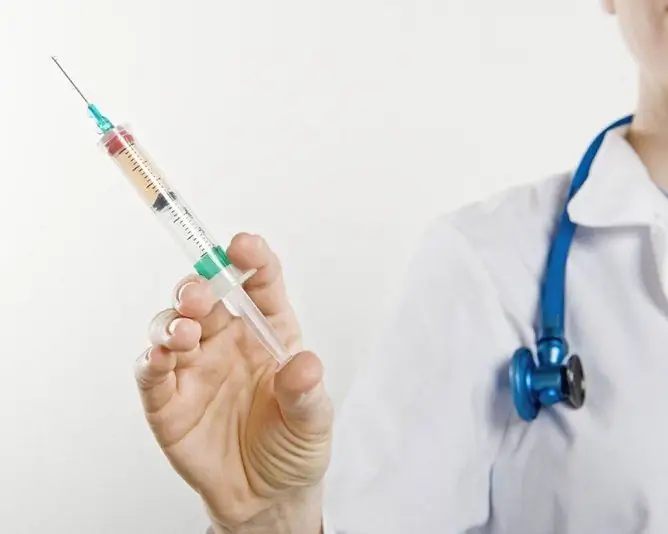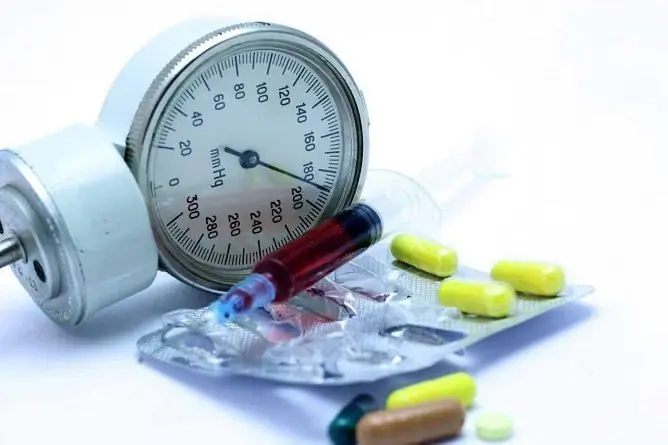Table of contents:
- Trazograph
- Release form and composition
- Pharmacological properties
- Indications for use
- Contraindications
- Trazograph, instructions for use: method and dosage
- Side effects
- Overdose
- special instructions
- Application during pregnancy and lactation
- With impaired renal function
- For violations of liver function
- Drug interactions
- Analogs
- Terms and conditions of storage
- Terms of dispensing from pharmacies
- Reviews about Trazograph
- Price for Trazograph in pharmacies
- Trazograph: prices in online pharmacies

Video: Trazograph - Instructions For Use, Price, Analogs, Reviews

2024 Author: Rachel Wainwright | [email protected]. Last modified: 2023-12-15 07:39
Trazograph
Trazograph: instructions for use and reviews
- 1. Release form and composition
- 2. Pharmacological properties
- 3. Indications for use
- 4. Contraindications
- 5. Method of application and dosage
- 6. Side effects
- 7. Overdose
- 8. Special instructions
- 9. Application during pregnancy and lactation
- 10. In case of impaired renal function
- 11. For violations of liver function
- 12. Drug interactions
- 13. Analogs
- 14. Terms and conditions of storage
- 15. Terms of dispensing from pharmacies
- 16. Reviews
- 17. Price in pharmacies
Latin name: Trazograph
ATX code: V08AA01
Active ingredient: sodium amidotrizoate (Sodium amidotrizoate)
Manufacturer: Unique Pharmaceutical Laboratories (India)
Description and photo updated: 30.11.2018
Prices in pharmacies: from 549 rubles.
Buy

Trazograph is an ionic radiopaque diagnostic tool for intravascular and intracavitary administration.
Release form and composition
The drug is produced in the form of a solution for injection: a transparent, somewhat viscous liquid, from light yellow to colorless; 76% solution - at room temperature or below it can crystallize (in a cardboard box 1 cellless cardboard contour package or 1 thermal container containing 5 dark glass ampoules of 20 ml each, complete with an ampoule knife, and instructions for using Trazograph).
Composition of 1 ml of 60% solution:
- active substance: meglumine diatrizoate - 600 mg (iodine content - 282 mg);
- auxiliary components: sodium dihydrogen phosphate dihydrate, sodium calcium edetate, water for injection.
Composition of 1 ml of 76% solution:
- active substances: meglumine diatrizoate - 660 mg (iodine content - 370 mg); sodium diatrizoate - 100 mg;
- auxiliary components: sodium hydroxide, calcium disodium edetate, water for injection.
Pharmacological properties
Pharmacodynamics
Trazograph is an ionic triiodinated radiopaque contrast agent. Increases the contrast of the image. The effect is associated with the absorption of X-rays, which is provided by the stably bound iodine included in the preparation.
Pharmacokinetics
Trazograph does not undergo metabolism, does not accumulate in the liver. Eliminates by glomerular filtration in a chemically unchanged form.
With the intravascular route of administration, the drug is distributed quickly in the intercellular space; connection with plasma proteins - no more than 10% of the dose. It does not penetrate through the intact blood-brain barrier.
With intravenous jet injection of 1 ml / kg of Trazograf, high plasma concentrations of the drug in the blood, corresponding to 2000–3000 mg iodine / l, are achieved within 5 minutes. T 1/2 (half-life) ranges from 1 to 2 hours.
Indications for use
Trazograph 60% is used for the following X-ray contrast research methods:
- excretory and infusion urography;
- angiocardiography;
- retrograde pyelography;
- cystography;
- peripheral arteriography;
- phlebography;
- selective angiography.
Radiopaque research methods for which it is recommended to use Trazograph 76%:
- splenoportography;
- excretory and infusion urography;
- aortography;
- coronary angiography;
- selective angiography;
- angiocardiography.
In children, the agent is used to conduct excretory urography.
Contraindications
Absolute:
- severe renal / hepatic impairment;
- severe arterial hypertension;
- severe hyperthyroidism;
- myocardial damage;
- circulatory failure in combination with symptoms of decompensation;
- pulmonary emphysema and active pulmonary tuberculosis;
- epilepsy;
- a state of collapse and shock;
- conducting myelography, cisternography and ventriculography (due to the likelihood of developing neurotoxic reactions);
- individual intolerance to the components of the drug and iodine-containing products.
Relative (the remedy is prescribed under medical supervision):
- impaired renal / hepatic function;
- cardiovascular insufficiency;
- pronounced atherosclerosis of the vessels of the brain;
- decompensated diabetes mellitus;
- hyperthyroidism;
- nodular goiter;
- plasmacytoma;
- pregnancy and lactation.
Trazograph, instructions for use: method and dosage
Preparing a patient for a radiopaque examination
The trazograph should be administered on an empty stomach, with no restrictions on water intake. If there are violations of water-electrolyte metabolism, they must be eliminated before the procedure. This is of particular importance for patients with decompensated diabetes mellitus, generalized myeloma, polyuria, gout or oliguria. Elderly patients and young children should not be limited to fluid intake before using hypertonic X-ray contrast agents.
To improve diagnostics during angiography of the vessels of the abdominal cavity and urography, it is recommended to thoroughly cleanse the intestines. In this regard, two days before the study, patients should avoid eating food that causes flatulence (this mainly applies to legumes, salads, fruits, any raw vegetables, black and fresh bread).
You need to take food for the last time no later than 18 hours before the start of the examination. It is considered advisable to take a laxative the night before. Long breaks in food intake, as well as the use of laxatives, are contraindicated in infants and young children.
In order to avoid the risk of developing a hypertensive crisis, against the background of pheochromocytoma, it is recommended to carry out preliminary preparation with the use of α-adrenergic receptor blockers.
Patients who are afraid of the procedure are shown the use of drugs with a sedative effect.
General rules for conducting X-ray contrast studies
A set of Trazograph solution in a syringe should be carried out immediately before the start of the examination.
You cannot use the substance remaining after the study. When performing angiography, it is necessary to frequently flush the used catheters with saline, this will minimize the possible risk of thromboembolism. The trazograph is easier to insert and better tolerated when using a solution heated to body temperature (heated immediately before the procedure). If a thermostat is used, only the number of ampoules that you intend to use need to be heated to T 37 ° C.
Due to the risk of severe allergic reactions, preliminary testing of individual sensitivity using low doses of Trazograph is not recommended.
Intravascular administration of the substance, if possible, is better when the patient is in the supine position. After the injection, careful monitoring of the patient's condition is required for at least 30 minutes, since the development of most complications is noted during this period. If it is necessary to use several high single doses, then the interval between the introduction of Trazograph should be 10-15 minutes (this allows compensation for increased serum osmolarity due to the influx of interstitial fluid). In cases of a single injection of more than 300 ml of Trazograph, intravenous infusion of electrolyte solutions is indicated.
X-ray contrast study of the urinary tract and kidneys
The trazograph is used for excretory urography, cystography and retrograde pyelography by intracavitary (in the renal pelvis, bladder) or intravenous administration.
Excretory urography:
- adults: a radiopaque contrast agent is injected intravenously at a rate of 0.3 ml / sec. 60% solution, 20–50 ml, or 76% solution, 20 ml. It is more advisable for patients with increased body weight to use Trazograph 76%;
- children: relatively high doses of the drug are required for the study, which is associated with a physiologically reduced concentration capacity of the still immature nephron of the kidneys; for the study, Trazograph 76% is used in the following doses: up to 1 year - 6 ml; 1-2 years - 8 ml; 2-6 years old - 10 ml; 6-12 years old - 12-14 ml; 12-15 years old - 16 ml.
Infusion urography: Trazograph for adults is injected intravenously at a rate of 20-30 drops / min. For the study, a mixture of 80 ml of Trazograph (60% or 76%) and 80 ml of 5% dextrose solution is used.
Retrograde pyelography: when carrying out intracavitary administration, it is advisable to dilute Trazograph with 5% dextrose solution or isotonic sodium chloride solution to obtain a 30% solution. The resulting solution should be injected retrograde into the urinary tract through a catheter under low pressure, while visual X-ray control is carried out (pain in the lumbar region should not be allowed). The usual dose is 3–8 ml of a 30% solution. In patients with ectasia of the cavities of the system, the dose can be increased to 20 ml or more (determined by the degree of expansion of the renal cavities).
Cystography: a 30% solution at a dose of 100-200 ml is injected into the bladder through an epicystostomy or retrograde (the volume should be slightly less than the bladder capacity), while visual X-ray control is performed.
X-ray contrast examination of blood vessels
For the purpose of conducting such studies as angiocardiography, aortography, arteriography, selective angiography, splenoportography, phlebography, the intravascular pathway is used to introduce Trazograf.
Recommended dosage regimen:
- aortography: Trazograph 76% at a dose of 30-60 ml is injected into the aorta at a rate of 25-35 ml / sec;
- angiocardiography: Trazograph 76% at a dose of 60 ml is injected at a rate of 10–30 ml / sec;
- peripheral arteriography: Trazograph 60% is injected intraarterially at a rate of 8–12 ml / sec; the dose for injection into the lower extremity is 20–40 ml, in the upper extremity - 10–20 ml;
- selective angiography: Trazograph 60 or 76% is injected at a rate of 3–12 ml / sec at a dose that corresponds to the volume of the studied vessel bed;
- phlebography: Trazograph 60% is administered intravenously at a rate of 3-5 ml / sec; dose for injection into the lower extremity - 20–40 ml, in the upper extremity - 10–20 ml;
- splenoportography: Trazograph 76% is injected into the spleen at a rate of 8 ml / sec at a dose of 30–50 ml.
Side effects
Adverse reactions associated with intravascular administration of Trazograph are usually transient, they are classified as mild or moderate, although there is information about the development of severe, life-threatening reactions, including those leading to death.
Most often, with intravascular administration of Trazograph, the following disorders were observed: vomiting, nausea, feeling of heat, redness of the skin. With the slow introduction of the substance or the introduction of short breaks (every 3-5 minutes), you can achieve a reduction in the sensation of heat and nausea.
Other possible disorders: dizziness, chills, sweating, fever, shortness of breath, lacrimation, sneezing, headache, pallor of the skin, weakness, vomiting and suffocation, decreased / increased blood pressure, muscle tremors, itching, urticaria, convulsions, edema.
It is possible that these side reactions may be a harbinger of developing anaphylactic shock. If it occurs, the administration of Trazograph is immediately stopped, if necessary, appropriate intravenous therapy is prescribed. The development of anaphylactoid and allergic reactions does not depend on the dose and method of administration of the solution. In patients with a predisposition to allergies, hyperergic reactions are more common.
When using Trazograf, circulatory disorders may occur, which are expressed as an expansion of peripheral vessels and a subsequent decrease in blood pressure, reflex tachycardia, shortness of breath, cyanosis, agitation, confusion, up to loss of consciousness. These side effects are severe and require urgent assistance.
It is necessary to take into account the likelihood of the development of these complications, for the provision of emergency care, appropriate medicines, an artificial respiration apparatus and an endotracheal tube should be ready. In isolated cases, mainly in patients with brain diseases or epilepsy, neurological complications may occur, including drowsiness, disorientation, visual impairment, temporary paresis, coma, and epileptic seizures.
In some cases, against the background of the use of Trazograf, thrombosis, phlebitis may develop, and reversible renal failure rarely occurs.
Overdose
In case of overdose or in patients with significantly reduced renal function, Trazograph can be removed from the body by extracorporeal dialysis.
special instructions
During storage of the Trazograph, crystals may fall out. In these cases, the ampoule with the solution must be heated, shaking occasionally, in a water bath (with a temperature of about 60 ° C). In this case, the crystals should dissolve and not form again when the preparation is cooled to 33–37 ° С. If they re-form after cooling to the specified temperature, the Trazograph cannot be used.
Influence on the ability to drive vehicles and complex mechanisms
Patients when driving motor vehicles should take into account the likelihood of delayed reaction.
Application during pregnancy and lactation
Trazograph during pregnancy / lactation is prescribed after assessing the ratio of expected benefits and possible harm.
Pregnant women are prohibited from performing hysterosalpingography.
Excretion of Trazograph in breast milk is low, based on experience it can be assumed that the risk of harm to the baby is negligible.
With impaired renal function
- severe renal failure: the use of Trazograf is contraindicated;
- impaired renal function: the drug should be used under medical supervision.
For violations of liver function
- severe hepatic impairment: the use of Trazograf is contraindicated;
- impaired liver function: the drug should be used under medical supervision.
Drug interactions
It should be borne in mind that Trazograph reduces the ability of thyroid tissues to accumulate radioisotope substances during diagnostic studies for a period of 14 days.
Against the background of diabetic nephropathy and in patients undergoing biguanide therapy, with the introduction of Trazograf, lactic acidosis may develop. In order to prevent this complication, it is recommended to discontinue the use of biguanides 48 hours before the procedure. To resume therapy, you need to make sure that there is no impairment of renal function.
In patients taking β-blockers, hypersensitivity reactions may be more pronounced.
In patients taking interleukin, the development of delayed reactions (including fever, itching, rash, joint pain) and the appearance of symptoms resembling the flu are more common.
Analogs
The analogs of Trazograf are Urografin, Triombrast, Novatrizoat, etc.
Terms and conditions of storage
Store in a place protected from secondary X-rays and light, at temperatures up to 30 ° C. Do not freeze the solution. Keep out of the reach of children.
The shelf life is 5 years.
Terms of dispensing from pharmacies
Dispensed by prescription.
Reviews about Trazograph
Since the drug is used only for diagnostic purposes, there are few reviews of Trazograph. It is noted that the agent quickly exerts the claimed effect and is well tolerated.
Price for Trazograph in pharmacies
The approximate price for Trazograph 76% (5 ampoules) is 535–652 rubles.
Trazograph: prices in online pharmacies
|
Drug name Price Pharmacy |
|
Trazograph 76% solution for injection 20 ml 5 pcs. 549 r Buy |

Maria Kulkes Medical journalist About the author
Education: First Moscow State Medical University named after I. M. Sechenov, specialty "General Medicine".
Information about the drug is generalized, provided for informational purposes only and does not replace the official instructions. Self-medication is hazardous to health!
Recommended:
Spring Adonis - Properties, Indications For Use, Reviews

Adonis is a herbaceous plant from the genus of buttercups. The pharmaceutical industry produces on the basis of adonis tincture and tablets of Adonizid, which are prescribed for cardiac neurosis, vegetative vascular dystonia, etc
Azitrox - Instruction, Use For Children, Price, Suspension, Capsules

Instructions for use Azitrox suspension and capsules. Information on dosing for children, contraindications, reviews, analogues and the price of the drug in pharmacies
Nicotine Patch - Price, Reviews, Indications

Nicotine patch is an effective remedy for weaning from nicotine addiction
Stopdiar - Instruction, Application For Children, Price, Reviews, Suspension

Instructions for use of Stopdiar in the form of a suspension, capsules and tablets. Information on doses for children, contraindications, reviews, analogues and the price of the drug in pharmacies
Erispirus - Instruction, Use For Children, Price, Tablets, Syrup

Instructions for use Erispirus tablets and syrup. Information on the dosage for children, contraindications, reviews, analogues and the price of the drug in pharmacies






